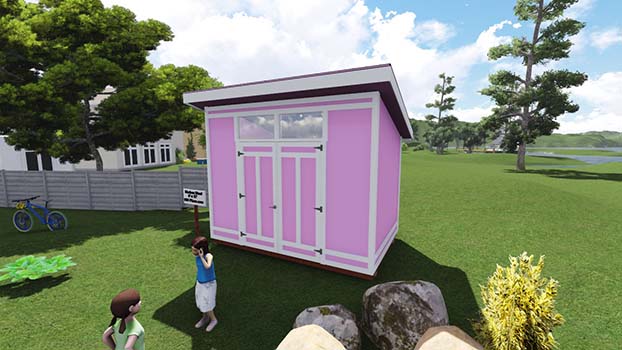Wednesday, November 6, 2024
How to create your perfect 8x12 shed on a budget

Okay, so you're dreaming of a shed. Maybe it's a cozy writing nook, a workshop for your crafting obsession, or a haven for your gardening tools. But the thought of building a shed conjures up images of hefty price tags and endless construction nightmares. Don't fret! Building your own 8x12 shed doesn't have to be a financial drain. Let's break it down, shed-by-shed, and find the perfect budget-friendly path to your very own haven.
Step 1: The Foundation of Your Budget
Think of your shed like a delicious pie: the crust (foundation) is crucial. A good foundation sets the stage for a sturdy and lasting shed. There are a few common options, each with its own budget implications:
Concrete Slab: This is the most durable option and can handle heavier loads. However, it's also the priciest. Consider DIY concrete pouring to save on labor costs.
Gravel Pad: A quick and economical choice, a gravel pad is perfect for lighter sheds. Be sure to use landscaping fabric beneath the gravel to prevent weed growth.
Pressure-Treated Skirts: This is an excellent choice for sloped terrain and can be a DIY project. The lumber itself is more expensive than gravel, but the overall cost can be comparable.
Step 2: Choosing the Right Materials - Where to Save and Where to Splurge
Now it's time to pick your building materials. This is where you can really get creative and find ways to save.
Lumber: Don't shy away from repurposed lumber! Check local salvage yards or craigslist for deals. You might even find beautiful reclaimed barn wood for that rustic charm. For new lumber, consider pressure-treated wood for the base and foundation, and standard framing lumber for the walls and roof.
Roofing: Shingles are a classic choice for a shed roof. Opt for basic asphalt shingles instead of fancy architectural ones.
Siding: You can go for simple wood siding, or even consider metal siding for a modern look. Remember, less is more in terms of detailing and accents.
Doors and Windows: Consider pre-hung doors and windows, they'll save you time and potential installation headaches. For budget-conscious choices, look for basic single-pane windows and solid core doors.
Step 3: DIY Power - Saving Big Bucks
Now, the big question: how much DIY are you comfortable with?
The Hands-On Approach: If you're a seasoned DIYer, you'll save a fortune by doing most of the work yourself. From foundation to framing, you can master each step with a little research and the right tools.
Mix and Match: Don't be afraid to hire help for specific tasks. Maybe you're confident with framing but want a professional to install the roof. Find a balance that suits your skills and budget.
Step 4: Creative Cost-Cutting Strategies
Shop Around: Compare prices from different lumber yards, hardware stores, and online retailers. You might be surprised at the price discrepancies.
Utilize Resources: Local libraries and community centers often have books and workshops on shed construction.
Ask for Help: Enlist friends or family members for a weekend of DIY fun.
Consider a Kit: While not always the cheapest option, pre-made shed kits can offer standardized plans and pre-cut materials, which can save you time and potentially reduce material waste.
Step 5: Making It Your Own - Adding Personal Touches on a Budget
Now it's time to add your personal touch!
Paint: A fresh coat of paint can transform a basic shed into a statement piece. Choose a color that complements your home or reflects your personality.
Landscaping: Simple landscaping around your shed can make it blend seamlessly into your yard. Use native plants to reduce water costs and create a welcoming atmosphere.
Upcycled Furniture: Give old furniture a new lease on life in your shed. An old dresser becomes a workbench, a vintage door becomes a charming accent wall, and a mismatched set of chairs creates a cozy reading nook.
Step 6: Beyond the Basics - Shed Upgrades That Add Value
Electricity: Adding a simple electrical circuit with outlets can make your shed even more functional.
Insulation: For year-round use, consider adding insulation to your shed for climate control.
Windows: Strategic placement of windows can add natural light and make your shed feel more spacious.
The Bottom Line: Building an 8x12 shed on a budget is absolutely achievable! With a little planning, research, and DIY spirit, you can create a beautiful, functional, and affordable space that you'll love for years to come. So, get out there, grab your tools, and let the shed building adventure begin!
No comments:
Post a Comment